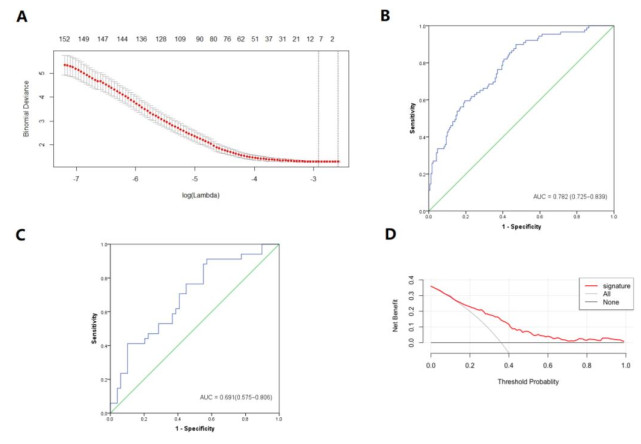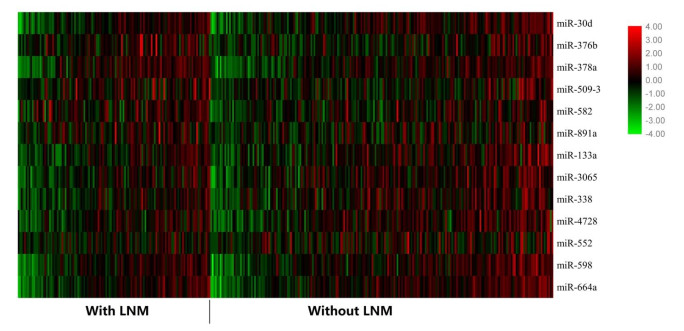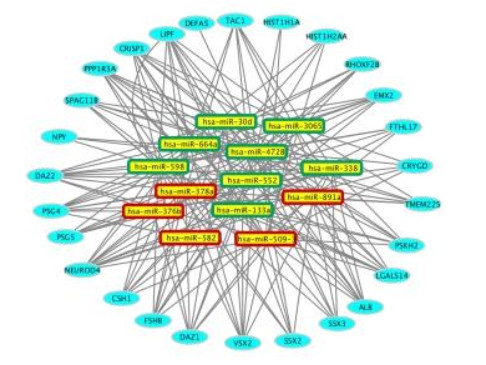|
[1]
|
K. X. Sun, R. S. Zheng, H. M. Zeng, S. W. Zhang, X. N. Zou, X. Y. Gu, et al., The incidence and mortality of lung cancer in China, 2014, Zhonghua Zhong Liu Za Zhi, 40 (2018), 805-811.
|
|
[2]
|
R. L. Siegel, K. D. Miller, A. Jemal, Cancer statistics, 2018, CA Cancer J. Clin., 68 (2018), 7-30.
|
|
[3]
|
A. McIntyre, A. K. Ganti, Lung cancer-a global perspective, J. Surg. Oncol, 115 (2017), 550-554.
|
|
[4]
|
A. Jemal, M. M. Center, C. DeSantis, E. M. Ward, Global patterns of cancer incidence and mortality rates and trends, Cancer Epidemiol. Biomarkers Prev., 19 (2010), 1893-1907.
|
|
[5]
|
M. J. Duffy, Clinical uses of tumor markers: A critical review, Crit. Rev. Clin. Lab. Sci., 38 (2001), 225-262.
|
|
[6]
|
P. Goldstraw, K. Chansky, J. Crowley, R. R. Porta, H. Asamura, W. E. Eberhardt, et al., The IASLC lung cancer staging project: Proposals for revision of the TNM stage groupings in the forthcoming (eighth) edition of the TNM classification for lung cancer, J. Thorac. Oncol, 11 (2016), 39-51.
|
|
[7]
|
A. Matsuda, K. Katanoda, Five-year relative survival rate of lung cancer in the USA, Europe and Japan, Jpn J. Clin. Oncol, 43 (2013), 1287-1288.
|
|
[8]
|
Y. Cai, X. Yu, S. Hu, J. Yu, A brief review on the mechanisms of miRNA regulation, Genomics, Proteomics Bioinf., 7 (2009), 147-154.
|
|
[9]
|
E. Chan, D. E. Prado, J. B. Weidhaas, Cancer microRNAs: From subtype profiling to predictors of response to therapy, Trends Mol. Med., 17 (2011), 235-243.
|
|
[10]
|
J. Ma, K. Mannoor, L. Gao, A. Tan, M. A. Guarnera, M. Zhan, et al., Characterization of microRNA transcriptome in lung cancer by next-generation deep sequencing, Mol. Oncol, 8 (2014), 1208-1219.
|
|
[11]
|
A. E. Kerscher, F. J. Slack, Oncomirs-microRNAs with a role in cancer, Nat. Rev. Cancer, 6 (2006), 259-269.
|
|
[12]
|
C. Sanfiorenzo, M. I. Ilie, A. Belaid, F. Barlesi, J. Mouroux, C. H. Marquette, et al., Two panels of plasma microRNAs as non-invasive biomarkers for prediction of recurrence in resectable NSCLC, PLoS One, 8 (2013), e54596.
|
|
[13]
|
J. Y. Kwan, P. Psarianos, J. P. Bruce, K. W. Yip, F. F. Liu, The complexity of microRNAs in human cancer, J. Radiat. Res., 57 (2016), i106-i111.
|
|
[14]
|
R. Tibshirani, Regression shrinkage and selection via the lasso, J. Roy. Stat. Soc. B, 58 (1996), 267-288.
|
|
[15]
|
C. Chen, H. Chen, Y. He, R Xia, TBtools, a toolkit for biologists integrating various HTS-data handling tools with a user-friendly interface, Bio. Rxiv, (2018), 289660.
|
|
[16]
|
H. Dweep, N. Gretz, miRWalk2. 0: A comprehensive atlas of microRNA-target interactions, Nat. Methods, 12 (2015), 697.
|
|
[17]
|
P. Shannon, A. Markiel, O. Ozier, N. S. Baliga, J. T. Wang, D. Ramage, et al., Cytoscape: A software environment for integrated models of biomolecular interaction networks, Genome Res., 13 (2003), 2498-2504.
|
|
[18]
|
F. Yang, K. Wei, Z. Qin, W. Liu, C, Shao, C. Wang, et al., MiR-598 suppresses invasion and migration by negative regulation of derlin-1 and epithelial-mesenchymal transition in non-small cell lung cancer, Cell Physiol. Biochem., 47 (2018), 245-256.
|
|
[19]
|
H. Y. Lee, S. S. Han, S. Y. Song, Serum microRNAs as potential biomarkers for lung cancer, Ann. Oncol., 27 (2016).
|
|
[20]
|
X. H. Wang, Y. Lu, J. J. Liang, J. X. Cao, Y. Q. Jin, G. S. An, et al., MiR-509-3-5p causes aberrant mitosis and anti-proliferative effect by suppression of PLK1 in human lung cancer A549 cells, Biochem. Biophy. Res. Commun., 478 (2016), 676-682.
|
|
[21]
|
Y. Z. Wang, J. M. Li, H. M. Chen, Y. Mo, H. Ye, Y. Luo, et al., Down-regulation of miR-133a as a poor prognosticator in non-small cell lung cancer, Gene, 591 (2016), 333-337.
|
|
[22]
|
F. Bray, J. Ferlay, I. Soerjomataram, L. A. Torre, A. Jemal, Global cancer statistics 2018: GLOBOCAN estimates of incidence and mortality worldwide for 36 cancers in 185 countries, CA Cancer J. Clin., 68 (2018), 394-424.
|
|
[23]
|
M. Cao, W. Chen, Epidemiology of lung cancer in China, Thorac. Cancer, 10 (2019), 3-7.
|
|
[24]
|
F. R. Vamos, J. Tovari, J. Fillinger, J. Timar, S. Paku, I. Kenessey, et al., Lymphangiogenesis correlates with lymph node metastasis, prognosis, and angiogenic phenotype in human non-small cell lung cancer, Clin. Cancer Res., 11 (2005), 7344-7353.
|
|
[25]
|
S. L. Yu, H. Y. Chen, G. C. Chang, et al., MicroRNA signature predicts survival and relapse in lung cancer, Cancer Cell, 13 (2008), 48-57.
|
|
[26]
|
S. Y. Sathipati, S. Y. Ho, Identifying the miRNA signature associated with survival time in patients with lung adenocarcinoma using miRNA expression profiles, Sci. Rep., 7 (2017).
|
|
[27]
|
L. Fang, J. Cai, B. Chen, S. Wu, R, Li, X. Xu, et al., Aberrantly expressed miR-582-3p maintains lung cancer stem cell-like traits by activating Wnt/β-catenin signalling, Nat. Commun., 6 (2015), 8640.
|
|
[28]
|
J. Liu, S. Liu, X. Deng, J. Rao, K. Huang, G. Xu, et al., MicroRNA-582-5p suppresses non-small cell lung cancer cells growth and invasion via downregulating NOTCH1, PLoS One, 14 (2019), e0217652.
|
|
[29]
|
L. L. Wang, M. Zhang, miR-582-5p is a potential prognostic marker in human non-small cell lung cancer and functions as a tumor suppressor by targeting MAP3K2, Eur. Rev. Med. Pharmacol. Sci., 22 (2018), 7760-7767.
|
|
[30]
|
K. Skrzypek, M. Tertil, S. Golda, M. Ciesla, K. Weglarczyk, G. Collet, et al., Interplay between heme oxygenase-1 and miR-378 affects non-small cell lung carcinoma growth, vascularization, and metastasis, Antioxid. Redox Signaling, 19 (2013), 644-660.
|
|
[31]
|
H. Y. Lee, S. S. Han, H. Rhee, J. H. Park, J. S. Lee, Y. M. Oh, et al., Differential expression of microRNAs and their target genes in non-small-cell lung cancer, Mol. Med. Rep., 11 (2015), 2034-2040.
|
|
[32]
|
H. Y. Lee, S. S. Han, S. Y. Song, Serum microRNAs as potential biomarkers for lung cancer, Ann. Oncol., 27 (2016).
|
|
[33]
|
X. H. Wang, Y. Lu, J. J. Liang, J. X. Cao, Y. Q. Jin, G. S. An, et al., MiR-509-3-5p causes aberrant mitosis and anti-proliferative effect by suppression of PLK1 in human lung cancer A549 cells, Biochem. Biophys. Res. Commun., 478 (2016), 676-682.
|
|
[34]
|
F. Xing, S. Sharma, Y. Liu, Y. Y. Mo, K. Wu, Y. Y. Zhang, et al., miR-509 suppresses brain metastasis of breast cancer cells by modulating RhoC and TNF-α, Oncogene, 34 (2015), 4890.
|
|
[35]
|
Q. Zhai, L. Zhou, C. Zhao, J Wan, Z. Yu, X. Guo, et al., Identification of miR-508-3p and miR-509-3p that are associated with cell invasion and migration and involved in the apoptosis of renal cell carcinoma, Biochem. Biophys. Res. Commun., 419 (2012), 621-626.
|
|
[36]
|
G. Korkmaz, C. Le Sage, K. A. Tekirdag, R. Agami, D. Gozuacik, miR-376b controls starvation and mTOR inhibition-related autophagy by targeting ATG4C and BECN1, Autophagy, 8 (2012), 165-176.
|
|
[37]
|
D. Chen, W. Guo, Z. Qiu, Q. Wang, Y. Li, L. Liang, et al., MicroRNA-30d-5p inhibits tumour cell proliferation and motility by directly targeting CCNE2 in non-small cell lung cancer, Cancer Lett., 362 (2015), 208-217.
|
|
[38]
|
Y. Li, P. Chen, L. Zu, B. Liu, M. Wang, Q. Zhou, MicroRNA-338-3p suppresses metastasis of lung cancer cells by targeting the EMT regulator Sox4, Am. J. Cancer Res., 6 (2016), 127-140.
|
|
[39]
|
X. Chen, L. Wei, S. Zhao, miR-338 inhibits the metastasis of lung cancer by targeting integrin beta3, Oncol. Rep., 36 (2016), 1467-1474.
|
|
[40]
|
P. Zhang, G. Shao, X. Lin, Y. Liu, Z. Yang, MiR-338-3p inhibits the growth and invasion of non-small cell lung cancer cells by targeting IRS2, Am. J. Cancer Res., 7 (2017), 53-63.
|
|
[41]
|
J. Sui, S. Y. Xu, J. Han, S. R. Yang, C. Y. Li, L. H. Yin, et al., Integrated analysis of competing endogenous RNA network revealing lncRNAs as potential prognostic biomarkers in human lung squamous cell carcinoma, Oncotarget, 8 (2017), 65997-66018.
|
|
[42]
|
X. Zhu, S. Ju, F. Yuan, G. Chen, Y. Shu, C. Li, et al., microRNA-664 enhances proliferation, migration and invasion of lung cancer cells, Exp. The.r Med., 13 (2017), 3555-3562.
|
|
[43]
|
F. Yang, K. Wei, Z. Qin, W. Liu, C. Shao, C. Wang, et al., MiR-598 suppresses invasion and migration by negative regulation of derlin-1 and epithelial-mesenchymal transition in non-small cell lung cancer, Cell Physiol. Biochem., 47 (2018), 245-256.
|
|
[44]
|
X. Tong, P. Su, H. Yang, F. Chi, L. Shen, X. Feng, et al., MicroRNA-598 inhibits the proliferation and invasion of non-small cell lung cancer cells by directly targeting ZEB2, Exp. Ther. Med., 16 (2018), 5417-5423.
|
|
[45]
|
L. Xu, B. Wei, H. Hui, Y. Sun, Y. Liu, X. Yu, et al., Positive feedback loop of lncRNA LINC01296/miR-598/Twist1 promotes non-small cell lung cancer tumorigenesis, J. Cell Physiol., 234 (2019), 4563-4571.
|
|
[46]
|
J. Kim, N. J. Lim, S. G. Jang, H. K. Kim, G. K. Lee, miR-592 and miR-552 can distinguish between primary lung adenocarcinoma and colorectal cancer metastases in the lung, Anticancer Res., 34 (2014), 2297-2302.
|
|
[47]
|
J. Cao, X. R. Yan, T. Liu, X. B. Han, J. J. Yu, S. H. Liu, et al., MicroRNA-552 promotes tumor cell proliferation and migration by directly targeting DACH1 via the Wnt/beta-catenin signaling pathway in colorectal cancer, Oncol. Lett., 14 (2017), 3795-3802.
|
|
[48]
|
N. Wang, W. Liu, Increased expression of miR-552 acts as a potential predictor biomarker for poor prognosis of colorectal cancer, Eur. Rev. Med. Pharmacol. Sci., 22 (2018), 412-416.
|
|
[49]
|
M. Xu, Y. Z. Wang, miR133a suppresses cell proliferation, migration and invasion in human lung cancer by targeting MMP14, Oncol. Rep., 30 (2013), 1398-1404.
|
|
[50]
|
L. K. Wang, T. H. Hsiao, T. M. Hong, H. Y. Chen, S. H. Kao, W. L. Wang, et al., MicroRNA-133a suppresses multiple oncogenic membrane receptors and cell invasion in non-small cell lung carcinoma, PLoS One, 9 (2014), e96765.
|
|
[51]
|
Y. Wang, J. Li, H. Chen, Y. Mo, H. Ye, Y. Luo, et al., Down-regulation of miR-133a as a poor prognosticator in non-small cell lung cancer, Gene, 591 (2016), 333-337.
|
|
[52]
|
D. Schmitt, L. M. Da Silva, W. Zhang, Z. Liu, R. Arora, S. Lim, et al., ErbB2-intronic microRNA-4728: A novel tumor suppressor and antagonist of oncogenic MAPK signaling, Cell Death Dis., 6 (2015), e1742.
|









 DownLoad:
DownLoad:





